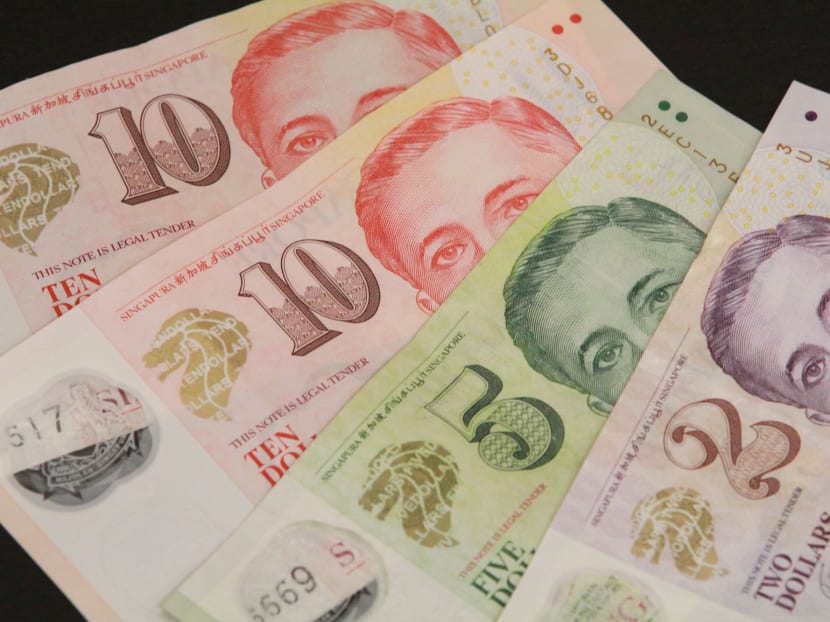Surprise MAS policy shift to rein in S$ rise
SINGAPORE — In a surprise announcement made before its scheduled policy statement in April, the Monetary Authority of Singapore (MAS) said yesterday it will ease its monetary policy and allow the Singapore dollar (SGD) to appreciate at a slower pace, sending the currency tumbling to its lowest since 2010 against the United States dollar (USD).

Singapore banknotes. TODAY file photo
SINGAPORE — In a surprise announcement made before its scheduled policy statement in April, the Monetary Authority of Singapore (MAS) said yesterday it will ease its monetary policy and allow the Singapore dollar (SGD) to appreciate at a slower pace, sending the currency tumbling to its lowest since 2010 against the United States dollar (USD).
Given the falling oil prices and a slightly weaker-than-expected pass-through effect of a tight labour market on consumer prices, MAS also slashed its inflation forecast for this year.
The Consumer Price Index (CPI) inflation for all items is expected to be between -0.5 per cent and 0.5 per cent, down from the earlier forecast range of between 0.5 and 1.5 per cent. Core inflation, which excludes accommodation and private road transport costs, is projected to be between 0.5 and 1.5 per cent, down from the previous range of between 2 and 3 per cent.
The monetary easing brought cheers from exporters, whose profit margins have been squeezed as a result of a strong SGD. However, economists said the impact on the overall economy is limited amid lacklustre global demand, and they also cautioned that domestic interest rates could rise faster as a result of the monetary easing.
The MAS has two scheduled policy announcements every year for April and October. Yesterday’s announcement was unusual, economists whom TODAY spoke to said. The economists noted that there were significant external developments which preceded the two previous occasions when the MAS issued unscheduled monetary policy statements: In 2005, after China abandoned its fixed-rate exchange policy and in 2001, following the terrorist attacks on New York’s World Trade Center.
CIMB economist Song Seng Wun said: “Previously when an unscheduled announcement happened, the economy was under duress, but that isn’t the case this time. The big shift this time is the change in inflation forecast ... I suppose that’s enough reason to take a more accommodative stance in policy.”
He added: “They could have waited until April, but this is also a pre-emptive move for the MAS to stay ahead and manage expectations before the January CPI release. It’s important to make the move now before market prices in the weaker figures.”
The easing in monetary policy and slashing of the inflation forecast came after the Republic experienced deflation for the last two consecutive months. The MAS said that since its last policy statement in October — when it maintained its stance, which has been put in place since April 2012, of a modest and gradual appreciation of the SGD — oil prices have continued to fall and domestic cost pressures stemming from a tight labour market have not been passed on to consumer prices as much as anticipated. These resulted in a “significant shift” in Singapore’s inflation outlook for this year, the MAS added.
An MAS spokesperson said the new policy stance is assessed to be “appropriate for ensuring medium-term price stability in the economy”.
On the timing of the announcement, she said: “Our main policy cycle remains as scheduled … However, we have always maintained the flexibility to conduct policy reviews in between the scheduled April and October cycles. This arrangement recognises that the Singapore economy is very open and that significant shocks in the external environment can have a sustained impact on the domestic growth and inflation outlook.”
The MAS’ decision is the latest in a wave of monetary easing by central banks in the region. This month alone, the European Central bank announced its quantitative easing plans while countries including Canada, Denmark and India cut interest rates.
Following the MAS’ announcement, the SGD experienced its biggest loss since 2010 by sinking as much as 1.3 per cent against the USD. The Republic’s currency has fallen almost 6 per cent against the greenback in the past three months.
UOB economist Francis Tan expects the SGD to drop to S$1.40 against the USD in the next six months from the current level of about S$1.36. However, that may not be enough to lift exports of the Republic’s economy, whose key electronics sector weakened for 28 consecutive months before registering an unexpected rebound last month. Mr Tan said: “Currency is just one factor in export competitiveness. It could make our exports more attractive but I don’t think the impact will be significant. What’s more important is to produce products that are relevant and in demand.”
Nevertheless, the economists said certain sectors such as tourism could benefit from the SGD appreciating at a slower pace, although the impact on the overall economy is limited — the MAS is maintaining its growth forecast of between 2 and 4 per cent this year.
Mr Song said: “It’s probably less bad for people in the region to travel to Singapore. But the impact of the MAS’ move on the economy at large would be fairly neutral because we’re not talking about a significant move on the currency front. Overall growth forecast will not see much material impact. We still await demand recovery globally.”





